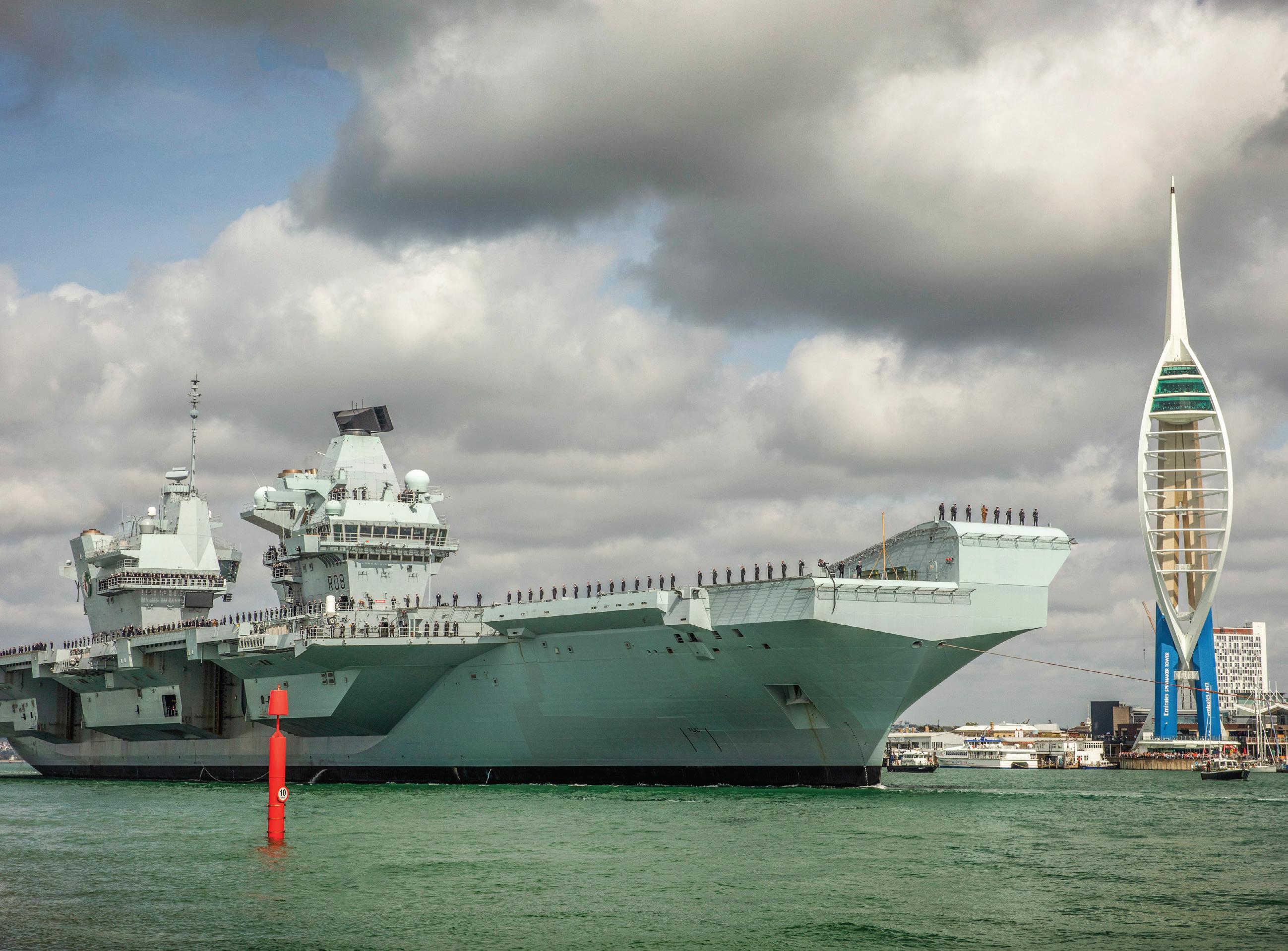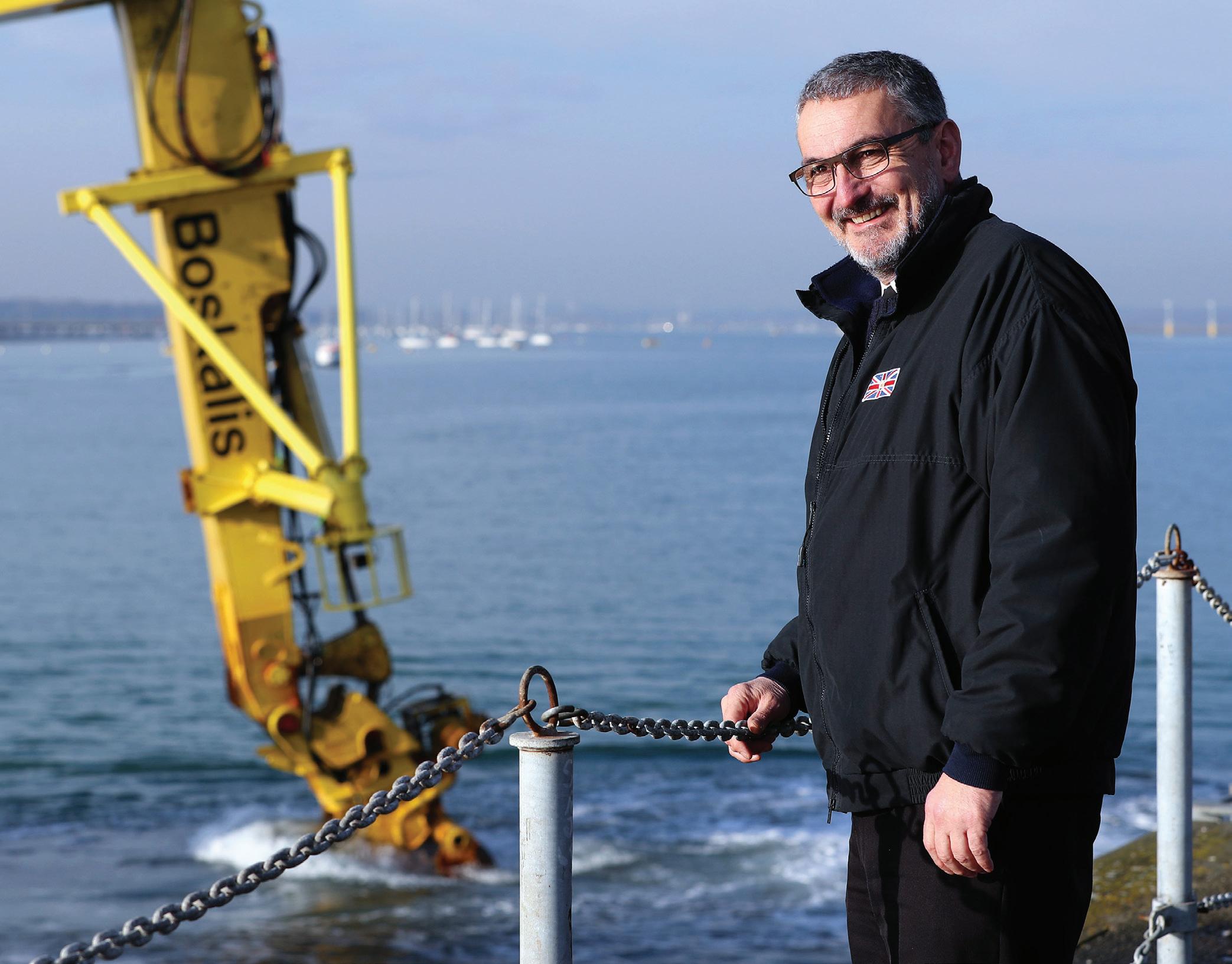
5 minute read
PREPARING THE HOMEPORT
PREPARING THE HOMEPORT
The work to prepare Portsmouth for the arrival of HMS Queen Elizabeth in 2017 and HMS Prince of Wales in 2019 was a mammoth and dangerous task. Simon Michell talks to the Queen’s Harbour Master to find out what this work entailed.
Portsmouth is probably the second busiest port in the country after Dover. We manage about 200,000 movements a year, including the Royal Navy (RN) warships, the cross-channel and Isle of Wight ferries, as well as a growing amount of commercial shipping. Portsmouth is where Fyffes bananas enter the country before ending up in your local supermarket’, explains the man who supervises all this activity, the Queen’s Harbour Master: Steve Hopper.
Hopper is very proud of the new commercial enterprises the port has managed to attract. Portsmouth is now also a major national sport and leisure site. ‘We have seven large marinas, there are over 3,500 moorings – more than at the Hamble which is the home of British yachting. Portsmouth even plays host to the world’s most famous yacht race – the America’s Cup’.
Portsmouth has only managed to remain such a booming site thanks to its continual evolution and reinvention. The next phase of this process is now complete – the modifications to enable the Royal Navy’s largest ever ships to make the port their home for the next 50 years. The refurbishment has covered a broad scope of activities – a new Vessel Traffic Management System (VTMS), a lengthened jetty, dredging, new harbour navigation aids, a special power supply substation and last, but not least, giant gangways so people can get on and off the new Queen Elizabeth-class carriers.
The Upgrade Programme on Land
One of the early parts of the £100 million Portsmouth upgrade programme was the installation of a new £5.5 million Vessel Traffic Monitoring System (VTMS). Although not strictly part of the Queen Elizabeth readiness programme, the old VTMS was becoming obsolescent and needed changing, having been originally installed in 1999. The new Kongsberg VTMS provides Hopper and his Harbour Services team improved situational awareness so that they can keep a close eye on the bustling ships, ferries, yachts, and naval vessels that are constantly criss-crossing the waters. ‘We have got more radars, better cameras, better computers. It makes everything more robust and easier to manage’, he explains. With two 65,000- tonne aircraft carriers about to be sailing in and out of the harbour, the new system is an essential element for ensuring the safety of all harbour users and operators.
There is now a pair of jetties capable of handling the two massive carriers: Princess Royal Jetty, which has already hosted HMS Queen Elizabeth, and the recently refurbished Victory Jetty. The RN has decided that the Princess Royal Jetty will be the maintenance berth for the carriers, and Victory Jetty will be the operational berth. So when HMS Prince of Wales enters Portsmouth for the first time she will go straight onto Princess Royal Jetty. VolkerStevin, the company that built the ammunition storage facility for the Type 45 destroyers in 2012, was awarded the jetty contract back in April 2015, just two months ahead of BAE Systems and Kongsberg winning the VTMS contract.

HMS Queen Elizabeth sets sail from HMNB Portsmouth to conduct her second deployment to the United States.
Royal Navy Photo by LPHOT Dan Rosenbaum, Crown Copyright
One of the most important carrier support systems, the power supply substation that converts the National Grid’s 50Hz power into the 60Hz used by all ships, is located between the jetty and Old Portsmouth. Weighing in at a huge 100 tonnes, the new frequency converter and motor represent an impressive feat of engineering. Now hooked up to the National Grid via 2.6 miles of cabling, they produce enough electricity to power a small town. Getting onto and off the aircraft carriers will require two gangways on a scale never yet seen in a British naval port. Designed by the Dutch firm Verhoef, the brows, as they are known in maritime lingo, will be big enough to cater for 3,000 people coming and going per hour. They were delivered in September 2016, ready for an intensive training programme to make sure everyone knew how to operate them before HMS Queen Elizabeth arrived in August 2017.
Modifications in the Water
Whilst all these enhancements have been in progress on land, there have been two major projects to make the waters of the harbour and its entrance ready for the leviathans to start using it. One of the United Kingdom’s (UK’s) leading dredging firms, the Hampshire-based Boskalis Westminster UK, won the £30 million contract to widen and deepen the 5-mile approach channel in July 2015. In all, about 3 million cubic metres of clay, sand and gravel have been scooped out by suction hopper and backhoe dredgers over an eight-month period. Care was taken not only to ensure that damage to the environment was kept to an absolute minimum, but also that they did not get blown up by German bombs dropped by the Luftwaffe as part of their failed air campaign to put the dockyard out of commission during World War II.

Queen’s Harbour Master Steven Hopper.
Royal Navy Photo By LPHOT Paul Hall, Crown Copyright
During the dredging, four major unexploded bombs were unearthed. A massive 500kg bomb was found in November 2016. Such was the danger that Portsmouth’s Gunwharf shopping centre and the Historic Dockyard had to be evacuated whilst Royal Navy explosive ordnance teams carried out a controlled explosion. Of all the elements to the work this is the one that makes Hopper most nervous, ‘I think to myself that I am dealing with a really big bomb here and there is a young RN diver swimming just a few yards away from it’.
Entering the Harbour
Getting in and out of the harbour for a ship the size of HMS Prince of Wales will not be a simple manoeuvre, as at more than 70 metres wide she is twice the width of the previous Invincibleclass carriers. This means she has to be positioned precisely within the newly dredged channel. To help the crew do this, giant navigation aids have been placed along the route into and out of the narrow harbour entrance. These are no ordinary navigation lights. Powered by a combination of solar panels and batteries, they sit on top of 14 huge steel towers that rise some 30 metres above the seabed. Weighing in at over 22 tonnes, each tower had to be lifted into place by a 350-tonne crane barge. ‘The lights atop the towers will only be switched on when one of the carriers is moving, but because the dredging work has slightly altered the direction of the main channel, a beacon has been put in for the other ports users, which will be permanently switched on’, says Hopper. This is just one more facet to the refurbishment that will benefit others beyond the aircraft carriers and their crews.










